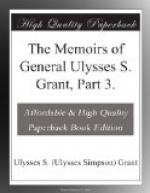In 1862 General Thomas Williams had come up from New Orleans and cut a ditch ten or twelve feet wide and about as deep, straight across from Young’s Point to the river below. The distance across was a little over a mile. It was Williams’ expectation that when the river rose it would cut a navigable channel through; but the canal started in an eddy from both ends, and, of course, it only filled up with water on the rise without doing any execution in the way of cutting. Mr. Lincoln had navigated the Mississippi in his younger days and understood well its tendency to change its channel, in places, from time to time. He set much store accordingly by this canal. General McClernand had been, therefore, directed before I went to Young’s Point to push the work of widening and deepening this canal. After my arrival the work was diligently pushed with about 4,000 men—as many as could be used to advantage—until interrupted by a sudden rise in the river that broke a dam at the upper end, which had been put there to keep the water out until the excavation was completed. This was on the 8th of March.
Even if the canal had proven a success, so far as to be navigable for steamers, it could not have been of much advantage to us. It runs in a direction almost perpendicular to the line of bluffs on the opposite side, or east bank, of the river. As soon as the enemy discovered what we were doing he established a battery commanding the canal throughout its length. This battery soon drove out our dredges, two in number, which were doing the work of thousands of men. Had the canal been completed it might have proven of some use in running transports through, under the cover of night, to use below; but they would yet have to run batteries, though for a much shorter distance.
While this work was progressing we were busy in other directions, trying to find an available landing on high ground on the east bank of the river, or to make water-ways to get below the city, avoiding the batteries.
On the 30th of January, the day after my arrival at the front, I ordered General McPherson, stationed with his corps at Lake Providence, to cut the levee at that point. If successful in opening a channel for navigation by this route, it would carry us to the Mississippi River through the mouth of the Red River, just above Port Hudson and four hundred miles below Vicksburg by the river.
Lake Providence is a part of the old bed of the Mississippi, about a mile from the present channel. It is six miles long and has its outlet through Bayou Baxter, Bayou Macon, and the Tensas, Washita and Red Rivers. The last three are navigable streams at all seasons. Bayous Baxter and Macon are narrow and tortuous, and the banks are covered with dense forests overhanging the channel. They were also filled with fallen timber, the accumulation of years. The land along the Mississippi River, from Memphis down, is in all instances highest next to the river, except where




